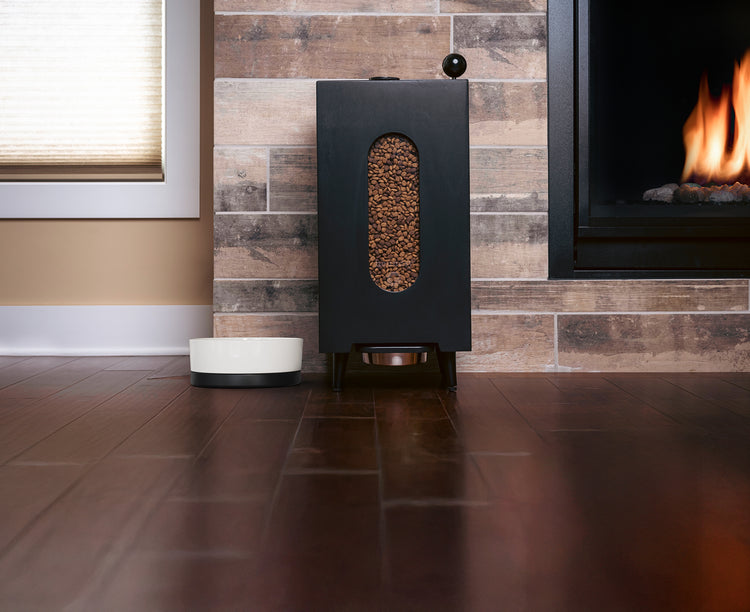Can I Leave Dry Dog Food Out Overnight? Understanding the Safety and Best Practices
- Houndsy
Table of Contents
- Introduction
- The Basics of Dry Dog Food
- Can I Leave Dry Dog Food Out Overnight?
- Best Practices for Feeding Your Dog
- Why Houndsy’s Kibble Dispenser is the Perfect Solution
- Conclusion
- FAQ
Introduction
Imagine this: it’s a hectic day, and you’ve just rushed out the door, leaving your beloved dog’s food bowl filled with kibble. You wonder, can I leave dry dog food out overnight? It’s a question many pet owners grapple with, especially those balancing busy lives with the needs of their furry companions.
In fact, a study from the American Kennel Club found that nearly 60% of pet owners admit to leaving their pets’ food out longer than recommended. This statistic highlights a common dilemma: how to manage our pets’ feeding routines without compromising their health and safety.
In this blog post, we’ll explore everything you need to know about leaving dry dog food out overnight, including potential risks, guidelines for safe feeding, and best practices to ensure your pet’s well-being. By the end of this article, we hope to equip you with the knowledge to make informed decisions about your dog’s feeding habits.
We’ll discuss factors that influence how long kibble can safely sit out, the implications of leaving food available for extended periods, and practical solutions for maintaining freshness. Let’s dive into the details of how to optimize your dog’s feeding routine while ensuring they enjoy every bite.
The Basics of Dry Dog Food
What is Dry Dog Food?
Dry dog food, commonly known as kibble, is a staple in many households due to its convenience and affordability. Typically made from a mixture of meat, grains, and vegetables, kibble is designed to provide balanced nutrition for dogs. The manufacturing process involves cooking and dehydrating the ingredients, which results in a shelf-stable product that can last for months when properly stored.
Why Do Pet Owners Use Dry Dog Food?
The popularity of dry dog food stems from several advantages:
- Convenience: Kibble is easy to store, measure, and serve, making it ideal for busy pet owners.
- Cost-Effectiveness: Generally, dry food is less expensive than wet food, allowing pet owners to feed their dogs a nutritious diet without breaking the bank.
- Dental Health: Chewing kibble can help reduce plaque and tartar buildup, promoting better dental health for dogs.
However, with these benefits come responsibilities—particularly concerning how we manage our dogs' feeding practices.
Can I Leave Dry Dog Food Out Overnight?
The Short Answer
In most cases, leaving dry dog food out overnight is generally safe, but there are important considerations to keep in mind. Factors such as the environment, the freshness of the kibble, and your dog’s individual needs play crucial roles in determining whether it’s advisable to do so.
Factors to Consider
-
Environmental Conditions:
- Humidity and Temperature: In humid or warm conditions, food can become stale more quickly, leading to potential mold growth or rancidity. If the area is dry and cool, kibble can typically stay fresh longer.
- Pest Control: Leaving food out can attract unwanted pests like ants or rodents. If you live in an area prone to such pests, it’s advisable to pick up any leftover food after each meal.
-
Kibble Freshness:
- Expiration Dates: Always check the expiration date on the packaging before serving. Kibble that is close to or past its expiration date may not be safe to leave out.
- Storage Practices: If kibble has been stored properly in a cool, dry place, it will generally last longer without spoiling.
-
Dog's Health and Behavior:
- Individual Preferences: Some dogs may be more sensitive to stale food than others. If your dog consistently refuses food left out overnight, it might be best to stick to scheduled meal times.
- Weight Management: Free feeding can contribute to obesity in pets, especially if they have constant access to food. Portion control is vital in maintaining a healthy weight.
Guidelines for Leaving Dry Dog Food Out
If you decide to leave dry dog food out overnight, consider the following guidelines:
- Limit Time: Aim to remove any uneaten food after 24 hours to ensure freshness and safety.
- Monitor Portion Sizes: Serve only what your dog is likely to eat in one sitting. This practice helps manage their caloric intake and prevents waste.
- Keep It Clean: Regularly clean your dog’s food bowl to prevent bacteria buildup.
Best Practices for Feeding Your Dog
Scheduled Feeding vs. Free Feeding
One of the fundamental decisions pet owners face is whether to adopt a scheduled feeding routine or allow free feeding.
Scheduled Feeding
Scheduled feeding involves providing meals at specific times throughout the day. Here are some benefits:
- Portion Control: Measures out the exact amount of food for each meal, helping to avoid overfeeding.
- Routine: Establishes a predictable routine for both pets and owners, which can aid in training and behavior management.
- Freshness: Reduces the chances of kibble becoming stale or contaminated.
Free Feeding
Free feeding allows dogs to graze on food throughout the day. While this method can work for some, it comes with risks:
- Overeating: Dogs may consume more than necessary, leading to obesity and other health issues.
- Staleness: Food left out can become stale or spoiled, affecting its palatability and nutritional quality.
Storage Solutions
The way we store dry dog food significantly impacts its freshness and safety. Here are our recommendations for optimal storage:
- Use an Airtight Container: Store kibble in a high-quality, airtight container to protect it from moisture, pests, and air exposure.
- Keep in Original Packaging: If possible, keep the kibble in its original bag within the container to maintain freshness.
- Avoid Heat and Sunlight: Store food in a cool, dry place away from direct sunlight to prevent nutrient loss and rancidity.
- Label with Dates: If you transfer kibble to a different container, label it with the purchase date to monitor freshness.
When to Discard Leftover Food
If food has been left out for more than 24 hours, it’s best to err on the side of caution and discard it. Signs that kibble has gone bad include:
- Unpleasant Smell: A rancid odor can indicate spoilage.
- Change in Texture: Soft or mushy kibble can signal moisture exposure.
- Visible Mold: Any signs of mold or pests mean the food is no longer safe for consumption.
Why Houndsy’s Kibble Dispenser is the Perfect Solution
At Houndsy, we understand the challenges pet owners face when it comes to feeding routines. That’s why we designed the Houndsy Kibble Dispenser—to simplify and elevate your dog-feeding experience.
Our dispenser features:
- Convenient Crank for Perfect Portions: No more bending down! The standing height crank allows for easy dispensing of kibble in precise portions.
- Large Storage Capacity: With a capacity of 25–30 lbs, you can store enough food for several days without worrying about frequent refills.
- Ergonomic Design: Our mid-century modern design complements any home decor, making feeding time stylish as well as functional.
- BPA-Free Liner: The food container is lined with BPA-free material to keep your dog’s food fresh and safe.
By using the Houndsy Kibble Dispenser, you can enjoy a seamless feeding experience that prioritizes both convenience and your pet’s health. Explore more about our innovative design here.
Conclusion
Leaving dry dog food out overnight is a common practice among pet owners, but it comes with risks that require careful consideration. By understanding the factors at play—such as environmental conditions, kibble freshness, and your dog’s individual needs—you can make informed decisions about your pet’s feeding habits.
Ultimately, adopting best practices for feeding and storage will help ensure your furry friend enjoys a healthy, balanced diet. If you’re looking to enhance your dog-feeding experience, consider the Houndsy Kibble Dispenser and our stylish Accessories collection designed for modern pet owners.
By prioritizing your pet’s well-being and convenience, we can elevate the everyday feeding ritual into a joyful experience for both you and your dog.
FAQ
1. How long can dry dog food sit out?
Dry dog food can generally sit out for up to 24 hours. After that, it’s best to discard any uneaten food to ensure your dog’s safety.
2. Does dry dog food go bad if left out?
Yes, dry dog food can spoil if left out for too long, especially in warm or humid conditions. Always check for signs of staleness or spoilage before feeding.
3. How should I store dry dog food?
Store dry dog food in an airtight container in a cool, dry place. Keeping it in the original packaging within the container can help maintain its freshness.
4. Is free feeding better than scheduled feeding?
Scheduled feeding is generally recommended for better portion control and to prevent obesity, while free feeding may lead to overeating and stale food.
5. What should I do if my dog refuses to eat food that’s been left out?
If your dog consistently refuses to eat kibble that has been left out, consider adjusting your feeding routine to scheduled meals and offering freshly served food.












